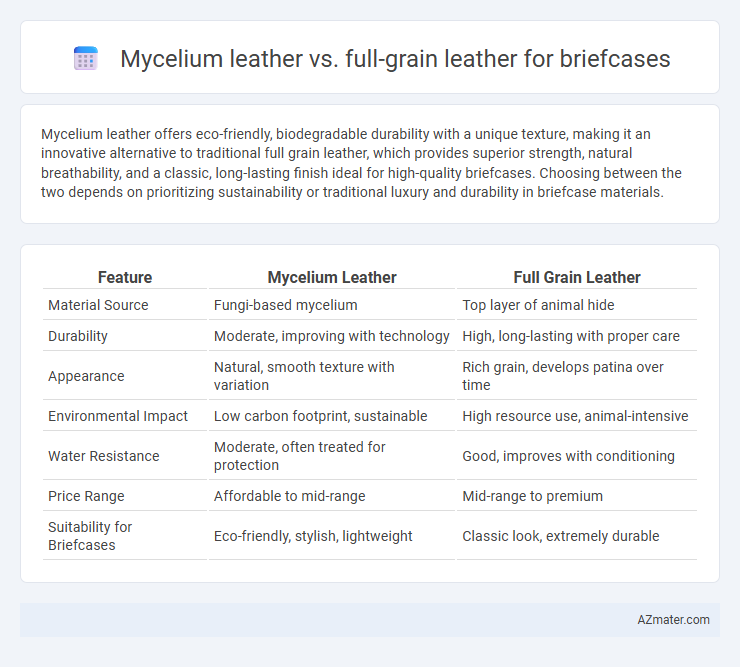Mycelium leather offers eco-friendly, biodegradable durability with a unique texture, making it an innovative alternative to traditional full grain leather, which provides superior strength, natural breathability, and a classic, long-lasting finish ideal for high-quality briefcases. Choosing between the two depends on prioritizing sustainability or traditional luxury and durability in briefcase materials.
Table of Comparison
| Feature | Mycelium Leather | Full Grain Leather |
|---|---|---|
| Material Source | Fungi-based mycelium | Top layer of animal hide |
| Durability | Moderate, improving with technology | High, long-lasting with proper care |
| Appearance | Natural, smooth texture with variation | Rich grain, develops patina over time |
| Environmental Impact | Low carbon footprint, sustainable | High resource use, animal-intensive |
| Water Resistance | Moderate, often treated for protection | Good, improves with conditioning |
| Price Range | Affordable to mid-range | Mid-range to premium |
| Suitability for Briefcases | Eco-friendly, stylish, lightweight | Classic look, extremely durable |
Introduction to Mycelium and Full Grain Leather
Mycelium leather, derived from the root structure of fungi, offers a sustainable alternative to traditional animal hides by utilizing biodegradable and renewable materials while maintaining durability and flexibility. Full grain leather, sourced from the top layer of cattle hide, is renowned for its strength, natural texture, and resistance to wear, making it a premium choice for high-quality briefcases. Both materials present unique benefits: mycelium leather excels in eco-friendliness and innovation, whereas full grain leather is prized for its timeless durability and rich patina development.
Material Origins and Sustainability
Mycelium leather, derived from the root structure of mushrooms, offers an innovative and eco-friendly alternative to traditional full-grain leather, which is sourced from animal hides through resource-intensive processes. Mycelium production significantly reduces environmental impact by requiring less water, land, and chemicals compared to the cattle farming and tanning involved in full-grain leather manufacturing. Choosing mycelium leather for briefcases supports sustainability through biodegradability and a lower carbon footprint while maintaining durability and a natural texture comparable to high-quality full-grain leather.
Production Processes Compared
Mycelium leather is produced through the cultivation of fungal mycelium, where the network of fine fungal threads grows on organic substrates, creating a sustainable, biodegradable material with lower environmental impact and reduced water use compared to traditional leather. Full grain leather involves the tanning of the top layer of animal hide, typically through chemical (chrome tanning) or vegetable-based processes, which require significant water, energy, and chemical inputs, often resulting in longer production cycles and higher pollution levels. The mycelium process offers a faster, more environmentally friendly alternative, while full grain leather ensures durability and natural texture through established, resource-intensive methods.
Durability and Longevity
Mycelium leather offers impressive durability with natural fungal fibers that resist wear and tear while being lightweight and flexible. Full grain leather, known for its dense fiber structure and resistance to scuffs, provides exceptional longevity and develops a unique patina over time, enhancing the briefcase's aesthetic. Both materials ensure durability, but full grain leather typically outperforms mycelium leather in long-term resilience and aging gracefully.
Aesthetics and Texture Differences
Mycelium leather offers a unique, slightly fibrous texture that mimics natural grain but with a more matte finish, providing an eco-friendly alternative visually distinct from traditional leather. Full grain leather exhibits a rich, natural patina and a smooth, supple feel that deepens with use, showcasing inherent surface imperfections. The aesthetics of mycelium leather lean toward modern, sustainable luxury, while full grain leather embodies classic elegance and timeless durability in a briefcase.
Weight and Flexibility
Mycelium leather for briefcases is significantly lighter than full grain leather, making it ideal for users seeking reduced weight without compromising durability. It offers greater flexibility, allowing the material to mold and adapt more easily to contents and daily use. Full grain leather, while heavier, provides a sturdy and rigid structure but lacks the pliability found in mycelium leather.
Environmental Impact
Mycelium leather offers a significantly lower environmental impact than full grain leather, as it requires less water, energy, and chemical use during production. Full grain leather involves intensive animal farming, contributing to deforestation, greenhouse gas emissions, and toxic tanning processes. Choosing mycelium leather for a briefcase supports sustainable material innovation and reduces reliance on traditional livestock-based resources.
Ethical Considerations
Mycelium leather offers a sustainable and cruelty-free alternative to traditional full grain leather, significantly reducing environmental impact by utilizing fungal fibers that require less water and no animal products. Full grain leather, derived from animal hides, raises ethical concerns related to animal welfare, including the conditions of livestock farming and the leather tanning process, which often involves toxic chemicals. Choosing mycelium leather for a briefcase aligns with ethical consumerism by promoting biodegradable materials and minimizing animal exploitation.
Cost Analysis
Mycelium leather offers a cost-effective alternative to full grain leather for briefcases, typically priced 20-30% lower due to lower raw material and production expenses. Full grain leather, derived from the top layer of animal hide, commands higher prices because of its durability, aging characteristics, and labor-intensive tanning processes. When comparing total ownership cost, mycelium leather also provides savings in maintenance and potential sustainability benefits, making it a compelling choice for budget-conscious consumers seeking eco-friendly alternatives.
Which Leather is Best for Your Briefcase?
Mycelium leather offers a sustainable and eco-friendly alternative to traditional full grain leather, with benefits like biodegradability and lower environmental impact, making it ideal for eco-conscious consumers. Full grain leather, renowned for its durability, natural texture, and ability to develop a unique patina over time, remains the top choice for those seeking long-lasting, premium-quality briefcases. Choosing between mycelium leather and full grain leather depends on whether sustainability or traditional craftsmanship is the priority for your briefcase.

Infographic: Mycelium leather vs Full grain leather for Briefcase
 azmater.com
azmater.com